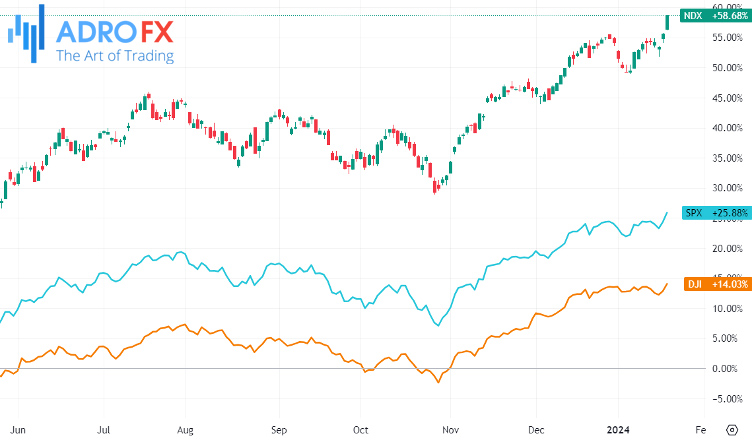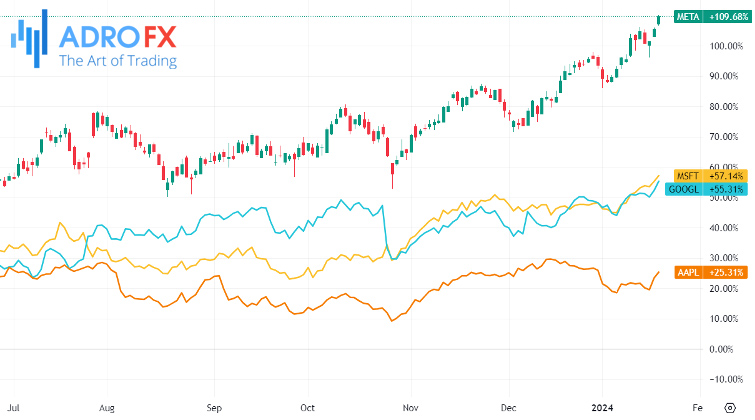S&P 500 Hits Record High, Tech Stocks Soar, and Global Economic Dynamics Unfold | Daily Market Analysis

Key events:
- Eurozone - ECB President Lagarde Speaks
- Japan - BoJ Interest Rate Decision
On Friday, the S&P 500 achieved an unprecedented high as investors continued to gravitate toward prominent tech stocks. This surge was fueled by encouraging data revealing heightened consumer sentiment and a moderation in inflation expectations.
The S&P 500 experienced a notable ascent of 1.2%, reaching a record of 4,839.81, while the Dow Jones Industrial Average also saw a robust increase of 1.1%. Simultaneously, the NASDAQ Composite exhibited a substantial rise of 1.7%.

Leading the charge in the realm of big tech were prominent companies such as Apple (NASDAQ: AAPL), Google (NASDAQ: GOOGL), Microsoft (NASDAQ: MSFT), and Meta (NASDAQ: META). Investors displayed a strong appetite for megacap tech stocks, driven by sustained optimism regarding the continued expansion of artificial intelligence and its potential to drive growth.

Meanwhile, chip stocks extended their recent gains, with notable performers including NVIDIA Corporation (NASDAQ: NVDA) and AMD (NASDAQ: AMD), which witnessed increases of over 4% and 7%, respectively. Super Micro Computer Inc (NASDAQ: SMCI) achieved a record high following an upward revision of its full-year outlook, citing robust demand driven by artificial intelligence.
The preliminary consumer sentiment index from the University of Michigan surged beyond expectations, reaching a reading of 78.8 in January. This marks the highest level since July 2021, compared to 69.7 in December. Additionally, one-year and five-year inflation expectations showed a decline to 2.9% and 2.8% from 3.1% and 2.9% in the previous month, respectively.
This positive economic and inflation outlook follows closely on the heels of Congress passing a bill to fund the federal government until March, contributing to the overall upbeat sentiment in the market.
The price of gold is struggling to capitalize on its recent two-day recovery from a one-month low and is facing renewed selling pressure in the Asian session on Monday. The US macro data, particularly Friday's positive consumer sentiment index, indicates a robust state of the economy. Combined with recent hawkish comments from influential Federal Reserve policymakers, this has tempered market expectations of an early rate cut. Consequently, this development is perceived as a significant headwind for the non-yielding precious metal.

In the realm of currencies, the Australian Dollar is hovering around the psychological level of 0.6600 on Monday, driven by market uncertainty surrounding discussions between the United States and the United Kingdom on escalating actions against Iran-backed Houthi terrorists in Yemen. Despite this uncertainty, the AUD/USD pair is receiving some support from a weakened US Dollar, influenced by a decrease in long-term US Treasury yields.

Australia's dollar is facing headwinds amid speculation about potential early interest rate cuts by the Reserve Bank of Australia, fueled by subdued figures in Aussie Consumer Confidence and Employment Change. However, the AUD could find positivity in the surge of the domestic share market, mirroring the rally in the US that propelled the S&P 500 and Nasdaq to new records on Friday.
Meanwhile, the US Dollar Index appears to continue its downward trend. However, concerns about potential disruption in maritime trade in the Red Sea could provide some support for the US Dollar. The US and the UK are contemplating an escalation of their campaign without triggering a broader conflict with Iran. As more ships divert away from the Suez Canal and the Red Sea, vessels are assessing the risks associated with navigating this region, leading to rising insurance costs. Opting for the alternative route around the southern tip of Africa may result in increased delivery times, shipping costs, and inflation.

This situation has the potential to enhance risk aversion sentiments, prompting traders to seek the safe-haven status of the US Dollar.
The Japanese Yen has gained some positive traction on the first day of the new week, moving away from its lowest level against the US Dollar since November 28, reached on Friday. This shift is attributed to concerns about slowing economic growth in China, coupled with the potential for a further escalation of geopolitical tensions in the Middle East, which is enhancing the JPY's relative safe-haven status.

Despite these factors, a significant upward movement for the JPY appears challenging in light of growing expectations that the Bank of Japan will maintain its ultra-dovish stance after a two-day policy meeting on Tuesday. Additionally, the overall positive sentiment in equity markets is likely to contribute to limiting gains for the Japanese Yen.









